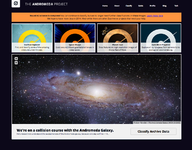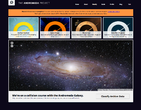Andromeda Project
Cs Portal > List of citizen science projects > Andromeda Project - (2013/11/14)
IDENTIFICATION
- Beta start date : N/A
- End date : Still open.
- Natural sciences > astronomy, astrophysics (space)
- Others in the same subject areas: Air Quality with Biomarkers, Bat detective, Budburst, Celebrate Urban Birds... further results
- Others projects about space: Galaxy Zoo, Solar Stormwatch, Space Warps, The Milky Way Project
⇳ Description The Andromeda galaxy is the closest spiral galaxy to our own Milky Way. Using PHAT data from the Hubble Space Telescope we're hunting for star clusters in Andromeda and hidden galaxies that lie behind. ➠ Purpose Star clusters are collections of hundreds to millions of stars that were born at the same time from the same cloud of gas. This shared origin makes star clusters unique tools for understanding how stars form and evolve. Additionally, they are useful for studying the major chapters in the history of galaxies. But before Andromeda's star clusters can unlock these secrets, we need the help of Citizen Scientists to find the clusters. Not just the big bright ones, but the small faint ones as well. This is the goal of the Andromeda Project. ? Research question Star clusters vary greatly in terms of mass, size, age, and local environment. As a result, star clusters can appear quite different from one another depending on the properties of the clusters and where they are located in the galaxy. This makes the process of identifying clusters tricky and difficult to automate. From the first year of PHAT data, a team of eight astronomers searched through each image, manually identifying star clusters by eye. Using less than 1/5th the total PHAT survey area, we cataloged about 600 star clusters (Johnson+ 2012). With the Andromeda Project, we hope that you will help us find the thousands of star clusters hiding in the rest of the survey!
Because the appearances of star clusters vary so much, it is important for us to learn what kinds of clusters we can actually see. For this reason, we have inserted realistic synthetic clusters with known ages, masses, and sizes into some of the PHAT images. By identifying both real and synthetic clusters, we will learn what types of clusters are undetectable in Andromeda. This information is critical for understanding the age and mass distributions of the clusters by allowing us to determine whether certain populations of clusters do not exist or if they are simply avoiding detection.
After you help us to find these star clusters, we will use several techniques to determine the age and mass of these objects. In some clusters, we can resolve individual stars that allow us to determine the age, mass, and other aspects of the object. In other clusters, where individual stars are too faint or too close together, we can use the summed light from a cluster to determine its properties (Fouesneau+ 2012, in prep.). With these ages and masses in hand, we can use these clusters to study a host of interesting topics: rapid and rare stages of stellar evolution, the structure and scale of star formation, the evolution of cluster populations, and how Andromeda has changed over billions of years.
TEAM
University of Washington
Project team page http://www.andromedaproject.org/#!/about/people/science-team Leader: Julianne Dalcanton Institution: University of Washington Partner institutions: Adler Planetarium, GLObal Robotic-telescopes Intelligent Array, Panchromatic Hubble Andromeda Treasury, Hubble, Zooniverse Contact: http://talk.andromedaproject.org/
USER TASKS
CONTRIBUTION TYPE: data analysis, data interpretation
PARTICIPATION TYPOLOGY:
GAMING GENRE NONE
GAMING ELEMENTS: NONE
◉ Tasks description Mark interesting features with circles and crosses. ⤯ Interaction with objects
▣ Interface
- Data type to manipulate: pictures
- interface enjoyment: cool/attractive
- Interface usability: easy to use
GUIDANCE
- Tutorial: ✓
- Peer to peer guidance: x
- Training sequence: x
- Individual performance: Somewhat
- Collective performance: Somewhat
- Research progress: Somewhat
❂ Feedback and guidance description
COMMUNITY
- Main news site:
- Frequency of project news updates: N/A
- Type of events:
- Frequency of events :
⏣ Community description
- Community size (volounteers based)
- Role:
- Interaction form:
- Has official community manager(s): N/A
- Has team work N/A
- Other:
- Community led additions:
Other information
PROJECT
Url:https://www.zooniverse.org/project/andromedaproject
Start date:
End date: Still open
TEAM
Official team page:http://www.andromedaproject.org/#!/about/people/science-team
Leader: Julianne Dalcanton
Institution: University of Washington
Partner institutions: Adler Planetarium, GLObal Robotic-telescopes Intelligent Array, Panchromatic Hubble Andromeda Treasury, Hubble, Zooniverse
Contact: http://talk.andromedaproject.org/
Main location: University of Washington
PROJECT DEFINITION
Subject
Natural sciences > astronomy, astrophysics (space)
Description
The Andromeda galaxy is the closest spiral galaxy to our own Milky Way. Using PHAT data from the Hubble Space Telescope we're hunting for star clusters in Andromeda and hidden galaxies that lie behind.
Purpose.
Star clusters are collections of hundreds to millions of stars that were born at the same time from the same cloud of gas. This shared origin makes star clusters unique tools for understanding how stars form and evolve. Additionally, they are useful for studying the major chapters in the history of galaxies. But before Andromeda's star clusters can unlock these secrets, we need the help of Citizen Scientists to find the clusters. Not just the big bright ones, but the small faint ones as well. This is the goal of the Andromeda Project.
Research question.
Star clusters vary greatly in terms of mass, size, age, and local environment. As a result, star clusters can appear quite different from one another depending on the properties of the clusters and where they are located in the galaxy. This makes the process of identifying clusters tricky and difficult to automate. From the first year of PHAT data, a team of eight astronomers searched through each image, manually identifying star clusters by eye. Using less than 1/5th the total PHAT survey area, we cataloged about 600 star clusters (Johnson+ 2012). With the Andromeda Project, we hope that you will help us find the thousands of star clusters hiding in the rest of the survey! Because the appearances of star clusters vary so much, it is important for us to learn what kinds of clusters we can actually see. For this reason, we have inserted realistic synthetic clusters with known ages, masses, and sizes into some of the PHAT images. By identifying both real and synthetic clusters, we will learn what types of clusters are undetectable in Andromeda. This information is critical for understanding the age and mass distributions of the clusters by allowing us to determine whether certain populations of clusters do not exist or if they are simply avoiding detection. After you help us to find these star clusters, we will use several techniques to determine the age and mass of these objects. In some clusters, we can resolve individual stars that allow us to determine the age, mass, and other aspects of the object. In other clusters, where individual stars are too faint or too close together, we can use the summed light from a cluster to determine its properties (Fouesneau+ 2012, in prep.). With these ages and masses in hand, we can use these clusters to study a host of interesting topics: rapid and rare stages of stellar evolution, the structure and scale of star formation, the evolution of cluster populations, and how Andromeda has changed over billions of years.
ABOUT PARTICIPANT TASKS
Tasks description.
Mark interesting features with circles and crosses.
.
| Grey typology | Participation typology | Contribution type: | ||||||||||||||||||||||||||||
|---|---|---|---|---|---|---|---|---|---|---|---|---|---|---|---|---|---|---|---|---|---|---|---|---|---|---|---|---|---|---|
|
|
|
||||||||||||||||||||||||||||
| Gaming | ||||||||||||||||||||||||||||||
| Genre: | Gaming elements: | |||||||||||||||||||||||||||||
| Interface | ||||||||||||||||||||||||||||||
| Data type to manipulate: pictures | interface enjoyment: cool/attractive Interface usability: easy to use |
Member profiles::N/A Member profile elements: |
||||||||||||||||||||||||||||
ABOUT GUIDANCE AND FEEDBACK
| Guidance | Feedback on | ||||||||||||
|---|---|---|---|---|---|---|---|---|---|---|---|---|---|
|
|
.
COMMUNITY
| Tools | News & Events |
|---|---|
|
Communication: website, blog, forum |
Main news site: |
| Community description | |
|
Community size (volounteers based): |
|
Other information about community:
Community led additions:
OTHER PROJECT INFORMATION
Capture d’écran 2013-11-14 à 15.17.15.png Yes [[has completion level::Medium]
http://www.andromedaproject.org/#!/about/people/science-team
University of Washington http://talk.andromedaproject.org/
Yes astronomy, astrophysics Natural sciences space Star clusters are collections of hundreds to millions of stars that were born at the same time from the same cloud of gas. This shared origin makes star clusters unique tools for understanding how stars form and evolve. Additionally, they are useful for studying the major chapters in the history of galaxies. But before Andromeda's star clusters can unlock these secrets, we need the help of Citizen Scientists to find the clusters. Not just the big bright ones, but the small faint ones as well. This is the goal of the Andromeda Project. Star clusters vary greatly in terms of mass, size, age, and local environment. As a result, star clusters can appear quite different from one another depending on the properties of the clusters and where they are located in the galaxy. This makes the process of identifying clusters tricky and difficult to automate. From the first year of PHAT data, a team of eight astronomers searched through each image, manually identifying star clusters by eye. Using less than 1/5th the total PHAT survey area, we cataloged about 600 star clusters (Johnson+ 2012). With the Andromeda Project, we hope that you will help us find the thousands of star clusters hiding in the rest of the survey!
Because the appearances of star clusters vary so much, it is important for us to learn what kinds of clusters we can actually see. For this reason, we have inserted realistic synthetic clusters with known ages, masses, and sizes into some of the PHAT images. By identifying both real and synthetic clusters, we will learn what types of clusters are undetectable in Andromeda. This information is critical for understanding the age and mass distributions of the clusters by allowing us to determine whether certain populations of clusters do not exist or if they are simply avoiding detection.
After you help us to find these star clusters, we will use several techniques to determine the age and mass of these objects. In some clusters, we can resolve individual stars that allow us to determine the age, mass, and other aspects of the object. In other clusters, where individual stars are too faint or too close together, we can use the summed light from a cluster to determine its properties (Fouesneau+ 2012, in prep.). With these ages and masses in hand, we can use these clusters to study a host of interesting topics: rapid and rare stages of stellar evolution, the structure and scale of star formation, the evolution of cluster populations, and how Andromeda has changed over billions of years.
Andromeda Project Mark interesting features with circles and crosses. data analysis, data interpretation
pictures, other:
Thinking: yes
Computing: no
Sensing: no
Gaming: no
cool/attractive easy to use yes no no N/A N/A N/A
N/A
N/A website, blog, forum Twitter
N/A
N/A
Medium
Bibliography
| BIBLIOGRAPHY |



